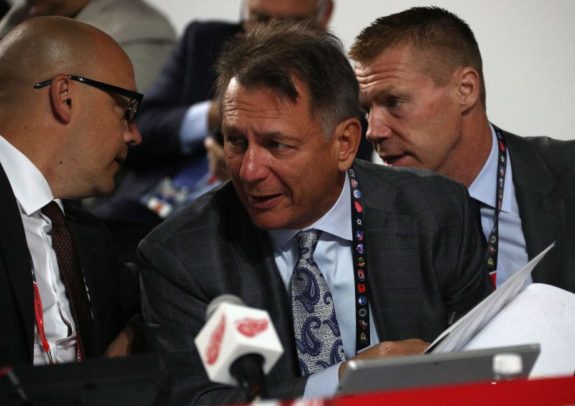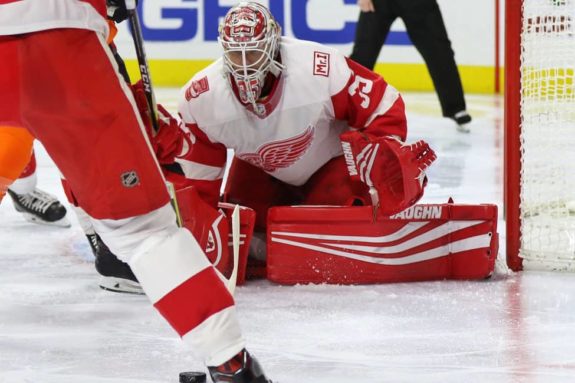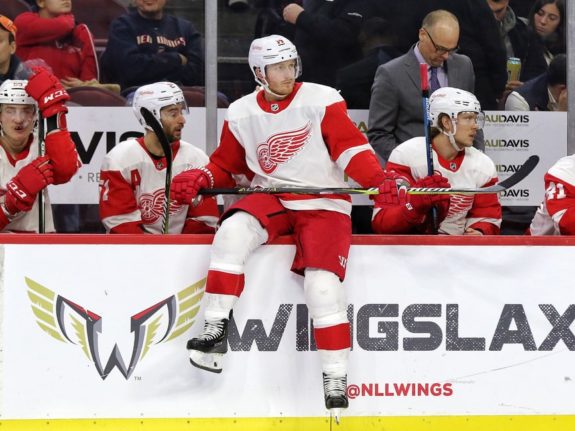During a recent interview, Detroit Red Wings general manager Ken Holland stated that his goal for the organization is to return to contention in 2019-20. After missing the past two postseasons and on-pace to do the same this season, Holland is rightfully hungry for a competitive team.
“As I make decisions over the next three weeks, what will have the most impact to me is, I want us to be better next season,” Holland told Helene St. James of the Detroit Free Press.

The 2019 NHL Trade Deadline, 2019 NHL Draft and free agency period present Holland with three opportunities to improve his bottom-five team, though their record doesn’t tell the whole story. As St. James pointed out, the Red Wings are 12-7-2 with both Danny DeKeyser and Mike Green in the lineup – good enough for 26 points in 21 games. It’s a small sample size, but a pretty solid quarter-season record for a rebuilding team.
Related: Red Wings’ 4 Burning Questions Ahead of the Deadline
So, how far off are the Red Wings from contending in 2019-20? Let’s take a look at their projected roster and prospect pipeline.
Projected Red Wings Roster
Using only players within the organization, here’s how Detroit’s lineup could look next season. Pending unrestricted free agents are excluded.
| LW | C | RW |
| Anthony Mantha | Dylan Larkin | Tyler Bertuzzi |
| Andreas Athanasiou | Frans Nielsen | Justin Abdelkader |
| Michael Rasmussen | Luke Glendening | Filip Zadina |
| Darren Helm | Jacob de la Rose | Evgeny Svechnikov |
| Christoffer Ehn |
| LD | RD | G |
| Danny DeKeyser | Mike Green | Jonathan Bernier |
| Jonathan Ericsson | Filip Hronek | Patrik Rybar |
| Dennis Cholowski | Trevor Daley | |
| Joe Hicketts |
Other roster candidates: Martin Frk, LW; Axel Holmstrom, C; Libor Sulak, D; Dominic Turgeon, C; Joe Veleno, C.
Realistic Output in 2019-20
With the roster above, the team doesn’t have the look of a contender – certainly not in net. Scoring may not be an issue, though, with Larkin progressing and Athanasiou, Bertuzzi and Mantha in contract years. But team defense and goaltending (especially) don’t have “playoffs” written on them.
Related: The Red Wings’ 2019 Deadline Trade Chips
For the sake of simplicity, let’s say the 2019-20 roster repeats its average game score. Younger players improve a little and veterans decline some, but let’s say it balances out. Here’s how each line’s combined average game score would look compared to that of an average contender. (from ‘How the Red Wings can build a contender during Dylan Larkin’s prime’ – The Athletic Detroit – 1/18/19)
| Grouping | Red Wings’ Avg. Game Score | Contender’s Avg. Game Score | Difference |
| Line 1 | 2.35 | 2.81 | -0.46 |
| Line 2 | 1.29 | 2.16 | -0.87 |
| Line 3 | 0.86* | 1.50 | -0.64 |
| Line 4 | 0.61** | 0.91 | -0.30 |
| Defense 1 | 0.98 | 1.26 | -0.28 |
| Defense 2 | 0.48 | 0.97 | -0.49 |
| Defense 3 | 0.29 | 0.49 | -0.20 |
| Total | 6.85 | 10.10 | -3.25 |
*Filip Zadina was given the average third-line game score of 0.37.
**Evgeny Svechnikov was given the average fourth-line game score of 0.25.
Lineup Additions
While the specific players on each line above are likely to change, there are a few places where the Red Wings could use an upgrade:
- Top-six winger
- Middle-six center
- Starting goalie
- Top-pairing defenseman
And, as we know, Holland won’t hesitate to bring in complementary players to bolster the lineup.
A couple of those needs could be resolved rather quickly by re-signing Jimmy Howard and Gustav Nyquist. If Howard can come close to his 2018-19 self, Detroit’s goaltending will be in good shape next season.

Whether it’s Nyquist or someone else in the top-six, having a 50-to-60-point producer would greatly benefit the Red Wings, as well. However, they’ll need to consider the likely $5 million-plus cap hit that comes with signing a top-six winger and how it will impact future contracts down the road.
Similarly, signing or acquiring a middle-six center would bode well for the organization from an immediate result standpoint. But then again, there’s also the cap hit.
Related: Should the Red Wings Bring Back Datsyuk?
A top-pairing defenseman would be the most difficult to bring aboard. Perhaps the Red Wings could dangle Athanasiou for a young, up-and-coming top blueliner. That, or sign Erik Karlsson, who is still scheduled to become a free agent this summer. Both scenarios are very unlikely, though.
Of the four needs, a starting goaltender and middle-six forward will happen, whether by trade or signing. Another forward is less likely, then a top-pairing defenseman would be the least likely addition.

With that being said, let’s make a few changes. There’s no way Holland sits on his hands when he wants to contend during the 2019-20 season.
- Re-sign Nyquist, Howard, and Jensen
- Sign an average third-line center
- Remove de la Rose (reserves), Ehn (minors), Zadina (minors – can’t you see him starting the season in Grand Rapids?) and Daley (trade).
In addition, a few players are likely to improve their average game score in more reasonably suited roles:
- Expanded role for Rasmussen (0.21 → 0.37)
- Expanded role for Cholowski (0.27 → 0.35)
- Better-suited role for Ericsson (0.05 → 0.15)
- Average third-line game score for Svechnikov (0.25 → 0.37)
With all of those changes, the Red Wings’ average game score jumps from 6.85 to 8.44, which is still short of the contender’s average game score (10.10). The biggest discrepancies come in two groupings: middle-six forwards and top-four defensemen.
Final Word
If the Red Wings want to compete during the 2019-20 season, they’ll need to do more than re-sign their key free agents and add a third-line center. Holland will need to bring in additional talent or the coaching staff will need to get more out of the players.
The team is certainly moving in the right direction, though. Larkin and Athanasiou’s ascendance coupled with a better, more consistent performance from Mantha bodes well for next season’s offense. The same could be said about Cholowski and Hronek’s emergence and DeKeyser playing better than in recent seasons. However, core pieces are still needed before the Red Wings can be considered a legitimate threat.
Credit to Corsica.Hockey for the data, Dom Luszczyszyn for the game score methodology, and Prashanth Iyer for advice on advanced analytics.